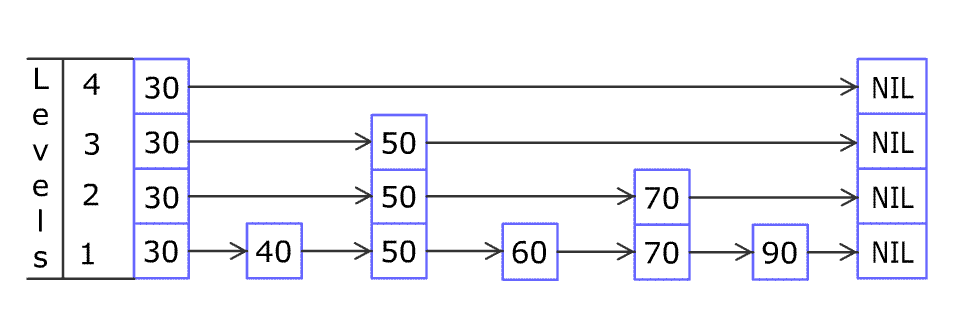1206. 设计跳表
题目描述:
不使用任何库函数,设计一个 跳表 。
跳表 是在 O(log(n)) 时间内完成增加、删除、搜索操作的数据结构。跳表相比于树堆与红黑树,其功能与性能相当,并且跳表的代码长度相较下更短,其设计思想与链表相似。
例如,一个跳表包含 [30, 40, 50, 60, 70, 90] ,然后增加 80、45 到跳表中,以下图的方式操作。

跳表中有很多层,每一层是一个短的链表。在第一层的作用下,增加、删除和搜索操作的时间复杂度不超过 O(n)。跳表的每一个操作的平均时间复杂度是 O(log(n)),空间复杂度是 O(n)。
了解更多 : https://en.wikipedia.org/wiki/Skip_list 🔗
在本题中,你的设计应该要包含这些函数:
- bool search(int target) : 返回target是否存在于跳表中。
- void add(int num): 插入一个元素到跳表。
- bool erase(int num): 在跳表中删除一个值,如果 num 不存在,直接返回false. 如果存在多个 num ,删除其中任意一个即可。 注意,跳表中可能存在多个相同的值,你的代码需要处理这种情况。
测试用例:
示例 1:
输入
["Skiplist", "add", "add", "add", "search", "add", "search", "erase", "erase", "search"]
[[], [1], [2], [3], [0], [4], [1], [0], [1], [1]]
输出
[null, null, null, null, false, null, true, false, true, false]
解释
Skiplist skiplist = new Skiplist();
skiplist.add(1);
skiplist.add(2);
skiplist.add(3);
skiplist.search(0); // 返回 false
skiplist.add(4);
skiplist.search(1); // 返回 true
skiplist.erase(0); // 返回 false,0 不在跳表中
skiplist.erase(1); // 返回 true
skiplist.search(1); // 返回 false,1 已被擦除
限制及提示:
- <= num, target <= 2 * 10^4
- 调用search, add, erase操作次数不大于 5 * 10^4
解题分析及思路:
这一题先不看题目的要求怎么去设计跳表,而是去完成这几个方法,你就会发现其实算不上困难题。
可以采用一个map去存储num再这个跳表中的个数,插入时,个数加一,删除时,个数减一即可
构造Skiplist结构体,并初始化
type Skiplist struct {
nums map[int]int
}
func Constructor() Skiplist {
return Skiplist{
make(map[int]int),
}
}
定义三个方法,对map进行取值后判断即可。
func (this *Skiplist) Search(target int) bool {
if count, ok := this.nums[target]; ok && count > 0 {
return true
}
return false
}
func (this *Skiplist) Add(num int) {
this.nums[num]++
}
func (this *Skiplist) Erase(num int) bool {
if count, ok := this.nums[num]; ok && count > 0 {
this.nums[num]--
return true
}
return false
}
复杂度:
- 时间复杂度:O(1)
- 空间复杂度:O(n)
执行结果:
- 执行用时: 36 ms, 在所有 Go 提交中击败了100.00%的用户
- 内存消耗:9.5 MB, 在所有 Go 提交中击败了57.56% 的用户
Tags :
通过次数 45.2K 提交次数 65K 通过率 69.5%
